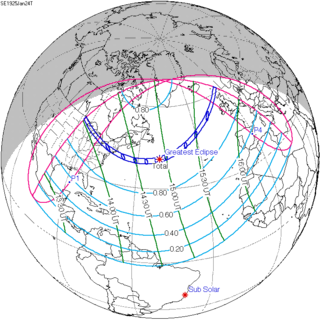| Solar eclipse of January 24, 1925 | |
|---|---|
| Type of eclipse | |
| Nature | Total |
| Gamma | 0.8661 |
| Magnitude | 1.0304 |
| Maximum eclipse | |
| Duration | 152 s (2 min 32 s) |
| Coordinates | 40°30′N 49°36′W / 40.5°N 49.6°W |
| Max. width of band | 206 km (128 mi) |
| Times (UTC) | |
| Greatest eclipse | 14:54:03 |
| References | |
| Saros | 120 (56 of 71) |
| Catalog # (SE5000) | 9339 |
A total solar eclipse occurred at the Moon's descending node of orbit on Saturday, January 24, 1925,[1] with a magnitude of 1.0304. A solar eclipse occurs when the Moon passes between Earth and the Sun, thereby totally or partly obscuring the image of the Sun for a viewer on Earth. A total solar eclipse occurs when the Moon's apparent diameter is larger than the Sun's, blocking all direct sunlight, turning day into darkness. Totality occurs in a narrow path across Earth's surface, with the partial solar eclipse visible over a surrounding region thousands of kilometres wide. Occurring only about 1.1 days after perigee (on January 23, 1925, at 13:30 UTC), the Moon's apparent diameter was larger.[2]
Totality was visible from southwestern and southeastern Ontario in Canada (including Toronto and Niagara Falls), Minnesota, Wisconsin, Michigan, Pennsylvania, New York (including the northern part of New York City), New Jersey, Connecticut, Rhode Island, and Massachusetts. A partial eclipse was visible for parts of North America, Central America, the Caribbean, northern ]]South America]], West Africa, and Western Europe.
- ^ "January 24, 1925 Total Solar Eclipse". timeanddate. Retrieved 2 August 2024.
- ^ "Moon Distances for London, United Kingdom, England". timeanddate. Retrieved 2 August 2024.
